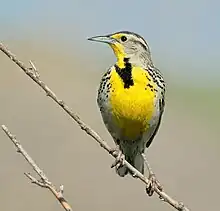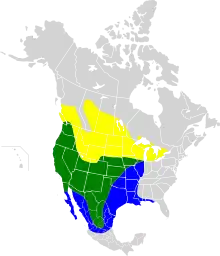Western meadowlark
The western meadowlark (Sturnella neglecta) is a medium-sized icterid bird, about 8.5 in (22 cm) in length. It nests on the ground in open grasslands across western and central North America. It feeds mostly on bugs, but will also feed on seeds and berries. The western meadowlark has distinctive calls described as watery or flute-like, which distinguish it from the closely related eastern meadowlark. The western meadowlark is the state bird of six states: Montana, Kansas, Nebraska, North Dakota, Oregon, and Wyoming.
| Western meadowlark | |
|---|---|
 | |
| Song | |
| Scientific classification | |
| Domain: | Eukaryota |
| Kingdom: | Animalia |
| Phylum: | Chordata |
| Clade: | Dinosauria |
| Class: | Aves |
| Order: | Passeriformes |
| Family: | Icteridae |
| Genus: | Sturnella |
| Species: | S. neglecta |
| Binomial name | |
| Sturnella neglecta Audubon, 1844 | |
 | |
| Range of S. neglecta Breeding range Year-round range Wintering range | |
Taxonomy
The western meadowlark was formally described in 1844 by the American ornithologist John James Audubon under its current binomial name Sturnella neglecta.[2] The specific epithet is from the Latin neglectus meaning "ignored", "overlooked", "neglected" or "disregarded".[3] Audubon explained that although the account of the Lewis and Clark Expedition of 1803–1806 mentioned yellow larks, these had never been formally described.[2][4] The type locality is Old Fort Union, North Dakota.[5]
Despite having "lark" in their name due to their melodic song, they are not true Larks, as they are instead in the New World Blackbird family.[6]
Two subspecies are recognised:[7]
- S. n. neglecta Audubon, 1844 – southwest, south central Canada through the west USA (except coastal Pacific Northwest) to central Mexico
- S. n. confluenta Rathbun, 1917 – coastal southwest Canada and northwest USA (southwest British Columbia to Oregon)
Western meadowlarks will occasionally interbreed with eastern meadowlarks where their ranges overlap; however, resulting young appear to have low fertility.[8]
Description
Western meadowlark adults have yellow underparts with a black "V" on the breast and white flanks streaked with black. Their upper parts are mostly brown, but also have black streaks. These birds have long, pointed bills and their heads are striped with light brown and black bands.
Measurements:[9]
- Length: 6.3–10.2 in (16–26 cm)
- Weight: 3.1–4.1 oz (88–116 g)
- Wingspan: 16.1 inches (41 cm)
These birds have a flute-like warbled song. These calls contrast with the simple, whistled call of the eastern meadowlark.
Distribution and habitat
The breeding habitats of western meadowlarks are grasslands, prairies, pastures, and abandoned fields, all of which may be found across western and central North America, as far south as northern Mexico. In regions where their range overlaps with the eastern species, these birds prefer thinner, drier vegetation; the two type of birds generally do not interbreed but do defend territory against one another. Their nests are situated on the ground and are covered with a roof woven from grass. There may be more than one nesting female in a male's territory. Nests are sometimes destroyed by mowing operations with eggs and young in them.
Western meadowlarks are permanent residents throughout much of their range. Northern birds may migrate to the southern parts of their range; some birds also move east in the southern United States.
It has also been introduced to Hawaii to control insects, and is now found on the island of Kauai. Attempted introductions to other islands failed, likely due to the presence of the small Indian mongoose, which is absent from Kauai.[10]
Behaviour and ecology
Breeding
.jpg.webp)
The nest is built by the female soon after arrival on the breeding grounds. The nest is placed in a concealed location on the ground. It is variable in form and ranges from a simple cup to a partially roofed structure with a runway extending from the nest entrance. Eggs are laid at daily intervals. Incubation only begins after the last egg is laid. The eggs measure on average 28 mm × 21 mm (1.10 in × 0.83 in) and have brownish spots and blotches on a white ground. The eggs hatch over a period of one or two days after being incubated by the female for 13–15 days. The young are altricial and nearly naked; their eyes are closed until the 4th day. Only the female broods the chicks. The nestlings are almost exclusively fed insects. The male brings food to the nest which is then usually fed to the chicks by the female. The young fledge at 10-12 day but are only capable of sustained flight at around 21 days. The young receive parental care for around 2 weeks after fledging. A second brood is attempted.[11]
The nests are parasitized by brown-headed cowbirds (Molothrus ater).[11]
Relationship to humans
The western meadowlark is the state bird of six states: Kansas, Montana, Nebraska, North Dakota, Oregon, and Wyoming. The northern cardinal, which represents seven states, is the only bird to hold the status of state bird in more states.
During the 2017 regular session of the Oregon Legislature, there was a short-lived controversy over the western meadowlark's status as state bird versus the osprey. The sometimes-spirited debate included state representative Rich Vial playing the meadowlark's song on his smartphone over the House microphone.[12] A compromise was reached in SCR 18,[13] which was passed on the last day of the session, designating the western meadowlark as the state songbird and the osprey as the state raptor.
References
- BirdLife International (2018). "Sturnella neglecta". IUCN Red List of Threatened Species. 2018: e.T22724256A132173994. doi:10.2305/IUCN.UK.2018-2.RLTS.T22724256A132173994.en. Retrieved 19 February 2022.
- Audubon, John James (1844). "Missouri Meadow-lark". The Birds of America, from drawings made in the United States and their territories. Vol. 7. New York: J.B. Chevalier. pp. 339–341, Plate 489.
- Jobling, James A. (2010). The Helm Dictionary of Scientific Bird Names. London: Christopher Helm. p. 267. ISBN 978-1-4081-2501-4.
- Allen, Paul; M'Vickar, Archibald, eds. (1843). History of the expedition under the command of Captains Lewis and Clark, to the sources of the Missouri, thence across the Rocky Mountains and down the river Columbia to the Pacific Ocean : performed during the years 1804, 1805, 18066 by order of the government of the United States. Vol. 1. New York: Harper and Brothers. p. 236.
- Paynter, Raymond A. Jr, ed. (1968). Check-List of Birds of the World. Vol. 14. Cambridge, Massachusetts: Museum of Comparative Zoology. pp. 180–181.
- Davis, Stephen K.; Lanyon, Wesley E. (March 2020). "Western Meadowlark (Sturnella neglecta), version 1.0". Birds of the World. Cornell Lab of Ornithology. doi:10.2173/bow.wesmea.01.
- Gill, Frank; Donsker, David; Rasmussen, Pamela, eds. (2020). "Oropendolas, orioles, blackbirds". IOC World Bird List Version 10.2. International Ornithologists' Union. Retrieved 9 October 2020.
- Jaramillo, Alvaro; Peter Burke (1999). New World Blackbirds: The Icterids. London: Christopher Helm. p. 305. ISBN 0-7136-4333-1.
- "Western Meadowlark Identification, All About Birds, Cornell Lab of Ornithology". www.allaboutbirds.org. Retrieved 2020-09-30.
- Pyle, Peter and Robert L. "The Birds of the Hawaiian Islands: Occurrence, History, Distribution, and Status" (PDF). hbs.bishopmuseum.org/. Retrieved 22 December 2022.
- Davis, S.K.; Lanyon, W.E. (2020). Poole, A.F. (ed.). "Western Meadowlark (Sturnella neglecta), version 1.0". Birds of the World. Ithaca, NY, USA: Cornell Lab of Ornithology. doi:10.2173/bow.wesmea.01. Retrieved 10 October 2020.
- "Lawmakers adjourn 2017 session with mixed results for biggest priorities". OregonLive.com. 8 July 2017. Retrieved October 15, 2017.
- "SCR 18". state.or.us. Retrieved October 15, 2017.
External links
- Xeno-canto: audio recordings of the western meadowlark
- Western meadowlark – Cornell Lab of Ornithology
- Western meadowlark – Sturnella neglecta – USGS Patuxent Bird Identification InfoCenter
- "Western meadowlark media". Internet Bird Collection.
- Western meadowlark photo gallery at VIREO (Drexel University)
